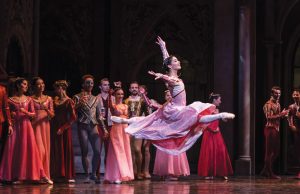Houston Ballet: Stanton Welch / Romeo and Juliet - Vancouver Ballet Society
- Home
- Reviews 2014 - 2019
- Houston Ballet: Stanton Welch / Romeo and Juliet

by Kaija Pepper
When the pas de deux are so sweet, the cast of characters so engaging and the design so fetching, there is every reason to welcome another Romeo and Juliet to ballet’s Shakespearean canon. Stanton Welch has given Houston Ballet a passion-filled, action-packed journey into doomed, young love.
Welch, an Australian who has been at the helm in Houston since 2003, has set his three-act Romeo and Juliet to the well-known Prokofiev score. Countless versions have been danced to the motif-rich orchestral composition (played live here by Houston Ballet Orchestra, conducted by Ermanno Florio). Familiarity brings with it some tension: given the evocative music, it’s hard not to remember a favourite version from the past and, inevitably, compare it with the present. Yet Welch’s ballet, which premiered at the end of February at Houston’s Wortham Theater Center, deserves to be experienced on its own merits.
Importantly, Welch has choreographed several luscious pas de deux for the leading couple. Opening night’s Romeo (Connor Walsh) and Juliet (Karina Gonzalez) created a compelling physical attraction that clearly had to run its course. From the moment they spotted each other in the ballroom, the two seemed to breathe as one; there was an inevitability to their coming together that was lovely to witness. In the balcony pas de deux, Walsh tossed Gonzalez into the air and around his body like she was water: liquid, light, elemental. The musicality of their dance seemed like a natural expression of their open, joyous delight in each other’s presence.
Sara Webb and Jared Matthews, second cast leads, were equally love-tossed, but it was as Rosaline that Webb really shone. Welch has developed this minor cameo of the woman for whom Romeo first pines into a full-bodied character, given substance by Webb’s etched line and sophisticated polish.
The third cast Juliet, Melody Mennite, had her own kind of magic during the balcony pas de deux; ardently supported by Romeo (Ian Casady), her trusting, voluptuous abandon vividly portrayed a young girl’s sexual awakening.
Welch has thickened the ballet’s plot not just with Rosaline, but also by introducing the House of Escalus, following Shakespeare’s play, to which both Mercutio and Count Paris belong. The difficulty for viewers is that Mercutio now straddles the Montague and Capulet camps, making him less firmly aligned with Romeo. Though poignantly danced by all three casts (Matthews, Charles-Louis Yoshiyama and Walsh), Mercutio had disappointingly few steps during his long death scene, when for much of the time he is either tended to by the women or held upright by the men.
If Welch was sparing here, elsewhere there is lively choreography for the men, as when Romeo’s two friends — Benvolio and, a new character in the ballet version, Balthazar — mince about with saucy hips and rubber legs, poking fun at Tybalt. Derek Dunn as Balthazar (in all three casts) was spot on every time with his pirouettes and bravado. There is also a great sense of sweep and musical detail in Welch’s ensembles.
The three families are colour coded; Roberta Guidi di Bagno has designed a distinctive palette of blues (for the House of Montague), reds (Capulet) and bronzes (Escalus). If that sounds simplistic, the overall design is anything but. Di Bagno, an Italian with 39 years of work around the world behind her, has created sumptuous costumes, with ribbons, masks and long, flowing dresses. One disconcerting note was the glitter in the brown robes of the clergy, including down-to-earth Friar Lawrence; was there a subtext here about religious decadence? If so, it wasn’t evident in the ballet itself. As well, Juliet’s sparkly, sugar-pink ball gown had a synthetic, brittle sheen.
Di Bagno also designed the sets, a splendid collection of flats, huge Renaissance-styled tapestries and silk curtains. A shifting array of interiors and exteriors form onstage within moments.
Welch gives some young ragamuffins their own dance in the carnival scene, adding generational breadth to his Romeo and Juliet that unfortunately missed the older end of the spectrum. The Nurse in her pointe shoes was noticeably of the same generation as Juliet, in all three casts (though Barbara Bears, retired from the company in 2009, was a little older, providing a hint of welcome maturity). Still, it was good to see this Nurse wasn’t an ancient doddering fool, as she is often portrayed; Welch has choreographed a strong comic character that just needs to lose her pointe shoes (the essence of youthful energy) and be cast more realistically (are there no character dancers looking for work?).
Houston Ballet’s new Romeo and Juliet should have a long life, giving time for the company’s excellent corps to grow into featured roles, for Welch to fine-tune and for Texans to become familiar with the ballet’s wealth of details in terms of character and design.
DI SUMMER 2015

